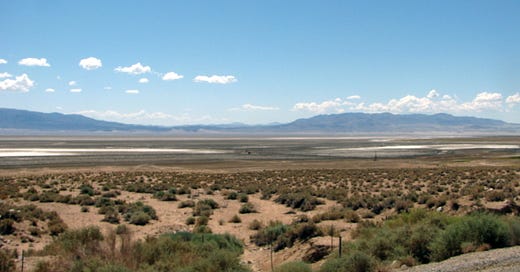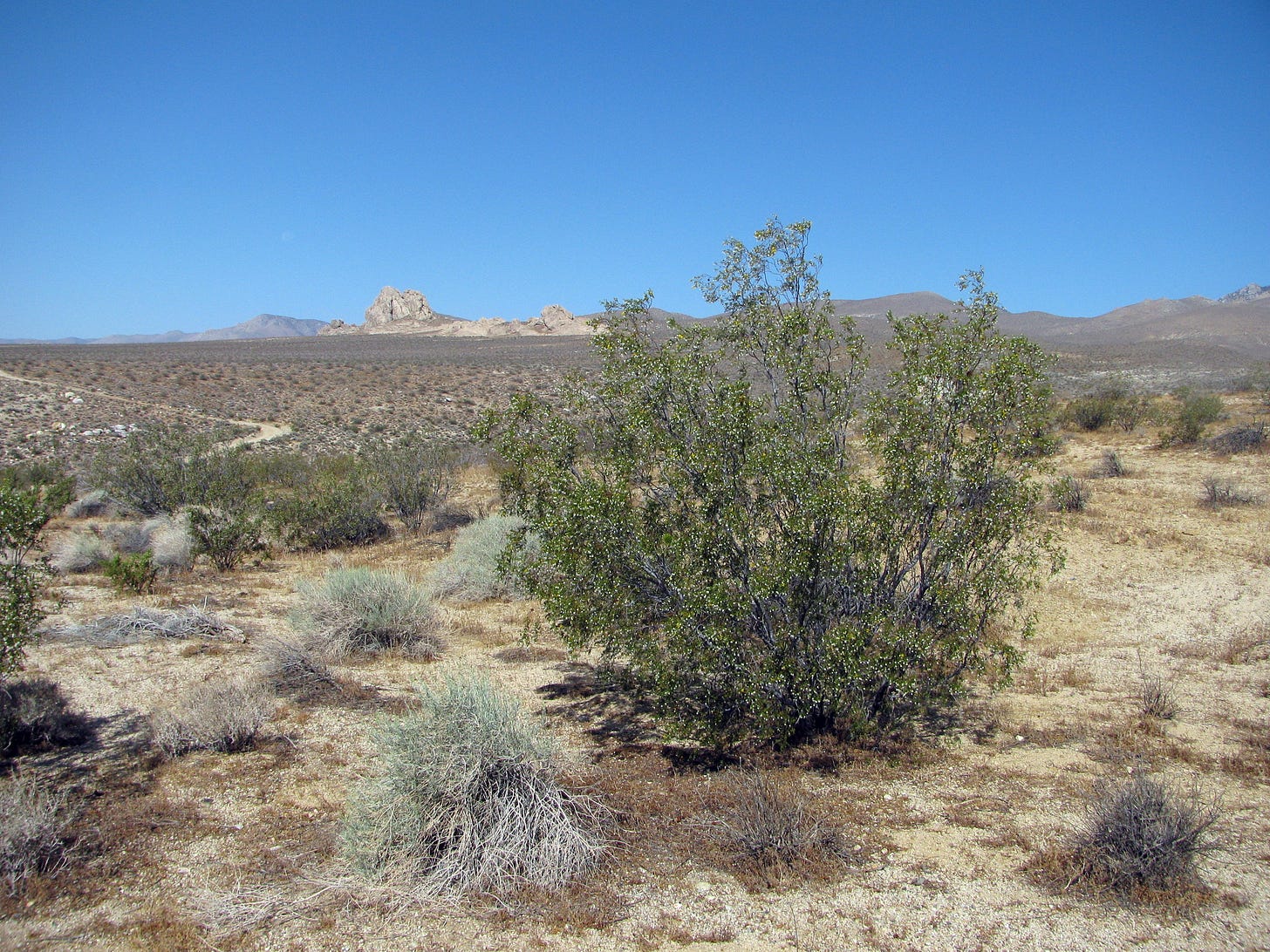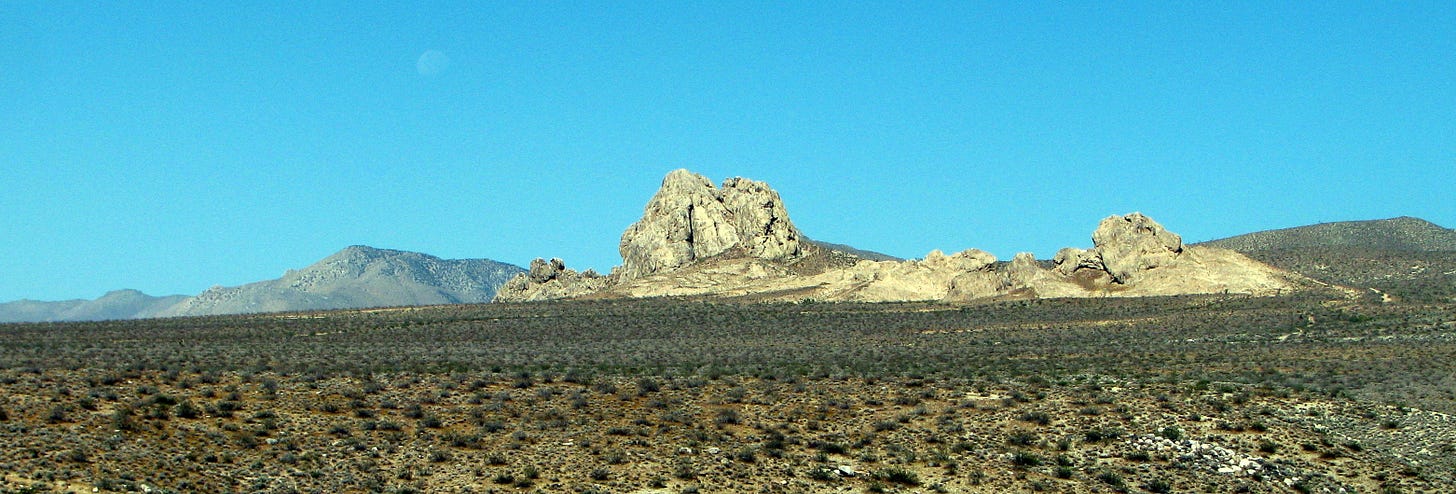[Bonus post this week! This is an edited excerpt from an essay I wrote in 2015, which I dug up because it relates to water issues in California, which are currently in the news because of the LA fires.]
I awoke the morning of my 46th birthday on top of the Los Angeles Aqueduct. Not immediately on top of it – it was buried at a depth of at least 25 feet in this spot – but just a few steps from our parked van it was exposed by a service shaft: an open concrete box lidded with a thick grate. Standing over it, I could hear the roar of water being sucked southwards by the thirsty urban monster 100 miles away. Down the hill from my vantage point, the giant metal drinking straw of the aqueduct's pipe emerged from the soil, spanned the dry creek below, and thrust itself back into the ground of the opposite slope. Another service shaft stuck up out of the hilltop above it, just like the one in front of me.
The Romans made far more elegant structures for the same purpose, but I marveled at the feat of engineering laid before (and underneath and behind) me. I wondered about the degree of angle it employed in order to run slightly downhill over such a long distance. I looked in vain for any sign of the tremendous excavation that must of taken place. Or did they bore a tunnel? If so, that must have been a big powerful machine. The engineering feats of the 20th Century are a wonder, as in a spectacle, to behold for their sheer scale and complexity. The long-term impacts of these projects, though, have not been so wonderful, as in beneficial.
So much of the land called "wild" in the western United States of America is like this: rammed through, cut clear or ridden over. The particular parcel where I started my birthday is managed by the Bureau of Land Management and is promoted as a recreation spot for OHVs (off-highway vehicles). Signage instructed riders to stay on marked trails due to the area being habitat for the endangered Desert Tortoise. Poor Gopherus Agassizii, who survived a dramatic – though gradual – change in climate that transformed a tropical forest into a desert (making it a "relict") only to have its burrows crushed by off-roaders. Of course, the not-so-gradual climate change of our own era could drive this creature to extinction. Such are the values of our society that unmonitored destructive activity is a legally-sanctioned and culturally acceptable use of "public" land.
If you don't mind digging a hole for your morning business, BLM land can be a great place to camp for free. As with the National Forests, you are allowed to stay overnight just about anywhere for up to 14 days as long as you are not blocking any roads. I had accepted the birthday-honor of choosing the night's camping spot and had picked this one because it was still in the desert, which we would soon be leaving. Nikki Hill and I were on our way to Portland, Oregon, from Joshua Tree, California, by way of U.S. Route 395, which starts near Hesperia, California, ends at the Canadian border, and passes through many truly scenic areas on the way.
We had camped on the edge of a place called Freeman Canyon. The terrain was rocky but softened by greasy-leaved, winnowy-branched Creosote Bush (which can form clonal colonies several thousand years old), grey-green, tufty-shrubbed Rabbit Bush – brightly adorned with summer's first blossoms of golden yellow – and frilly carpets of dessicated Cryptantha, its ephemeral flowers long spent from their brief exclamation.
The lower reaches of the Sierra Nevada range were marked by a dramatic multi-lobed outcropping of stone protruding from the landscape like bone through flesh. Large black ants filed back and forth from their home in a column a foot-wide, collecting seeds. It was quiet except for the wind. No OHVs or anything else disturbed the home turf of our threatened, shelled friend at that moment.
After breakfast, Nikki and I hit the road but did not leave the environs of the aqueduct, which shadows Route 395 for nearly 200 miles from that point north. Soon we were driving alongside the site of the former Owens Lake, which was once a large body of water (12 miles long by 8 miles wide), fed by the Owens River. In 1913, the Los Angeles Department of Water and Power (LADWP) re-routed the river into the brand new Los Angeles Aqueduct. A little more than a decade later, the lake was almost entirely desiccated. Since then, groundwater pumping by the LADWP to supplement the take from the river has lowered the surrounding water table enough to dry up other seeps and springs that nourished the area.
The destruction of Owens Lake and the lower Owens River was – and is – an ecological disaster. Previously, millions of migratory birds had used it as a vital stop-over, but their habitat was drastically reduced. Meadows of native flora – which early European visitors described as filling the valley floor as far as the eye could see – have desertified. The lake bed's exposed alkali soil, whipped up by the wind, is the single largest source of dust pollution in the United States, according to the EPA, and contains toxic constituents such as cadmium, chromium, chlorine and iron that are harmful to breathe.
The construction of the aqueduct sparked what are famously known as the "California Water Wars," which set Owens Valley farmers against the LADWP. The LADWP's bad behavior began even before the aqueduct was built, when they sent agents to the area posing as farmers who bought up as many parcels as they could in order to gain the water rights for the utility. In the 1920's and 1930's, Owens Valley farmers actually dynamited portions of the canal to provide themselves with irrigation water. The conflict is often styled, sometimes romantically, as the classic country vs. city clash – of simple agricultural folk struggling to survive an assault by effete urban hedonists – but this simplistic treatment ignores certain historical realities of the area: namely, its invasion and conquest by Europeans in the mid-1800's.
Previously, the Owens River valley was the home to semi-nomadic Native Americans, specifically the Paiutes. They called the river, Wakopee, and the lake, Pacheta. They hunted, gathered, and practiced agriculture. Their diet included wild hyacinth tubers, yellow nutgrass corms, grass seeds, and Pinyon Pine nuts. They hunted deer, desert big horn sheep, small game and caught fish. They also collected the pupae of the Alkali Fly (Ephydra hyans) an insect that laid its eggs on the surface of the lake; the pupae would build up along the shores where they were easily collected and then dried for storage.
The fact that the Paiutes built a ditch irrigation system for watering certain of their crops has been cited to justify the use of canals by ranchers; however, the methods differed in purpose, operation and scale. The Paiute used their system to expand the range of native plants they ate, not to support imported animals or crops. Dams built on the Wakopee were often seasonal constructions, in place for only a portion of the year, and any fish stranded in the channel by the lowered water flow were conscientiously harvested; a philosophy of wasting nothing. Conversely, modern ranchers make permanent diversions, ignore the effects they are having downstream and are wasteful. A common sight on ranched lands, including the the Owens Valley, is the use of large sprinkler systems spitting out streams of water in the middle of the day; water loss through evaporation under those circumstances can be as high as 50%.
Among the first European visitors to the Owens Valley were "mountain men" Jedediah Smith, in 1836, and Joseph Walker, in 1834. In 1845, John C. Fremont, a military officer and later the first Republican candidate for President, led the first full-fledged expedition into the area. Fremont named the valley, river and lake after his compatriot, Richard Owens, who had served with him during the seizure of Alta California from Mexico. Not once in his life did Owens ever see the area. (Here is yet another opportunity for re-naming as decolonization.)
Until 1859, few Europeans visited, but in that year a military force led by a Captain John W. Davidson was organized and sent there for the nominal purpose of recovering stolen horses from Native Americans. When they met the Paiutes, Davidson was impressed, describing them as "interesting, peaceful, [and] industrious." (A first person account by a member of the expedition expresses their positive impressions in detail.) Furthermore, the Paiutes had not approved of the horse-theft and had already disciplined the perpetrators, some with the penalty of death.
On this expedition no blood was shed and everyone parted on good terms. Davidson pledged to the Paiutes that "so long as they were peaceful and honest the government would protect them in the enjoyment of their rights." The Paiutes replied that "such had always been their conduct and should ever be – that they had depended on their own unaided resources – that they had at all times treated the whites in a friendly manner and intended to do so in the future” [my emphasis]. They also promised that anyone in their tribe who broke this word would be "punished with the sword." Davidson closed by saying to the interpreter: "Tell him that we fear it not, that what I have said I have said. I have lain my heart at his feet; let him look at it."
Everything went downhill from there. Davidson's attempt to set aside the area as a reservation failed when Congress did not pass the needed legislation. (Not that this would have guaranteed protection for the Paiutes, as the history of broken U.S. treaty obligations with Native Americans illustrates all too well.) Meanwhile, cattlemen and prospectors started arriving in the area, their numbers swelling quickly. The winter of 1861-62 was severe, bringing suffering to the Paiutes due to the lack of game to hunt the following spring. Conflicts with the settlers began when a Paiute killed a steer that was grazing on their hyacinth fields.
The European settlers had little or no respect for the rights and lifestyles of the indigenous people and soon the situation escalated to bloodshed. In mid-1862, the settlers asked for, and got, a U.S. military force sent to the area to bolster their side. By 1863, the Paiutes had been subdued. Owens Valley now belonged to the invaders, who were predominantly ranchers.
Only fifteen years later, in 1878, excessive irrigation by the ranchers caused the water levels of Owens Lake to start dropping. In other words, their methods were already unsustainable before the arrival of the aqueduct, a fact now little remembered. The plain truth is that, lake or no, the arid Owens Valley is not an appropriate place to raise cattle. It is in defiance of all logic (except that of the short-term financial) that ranching has been allowed to remain there at all.
Ecological issues entered the "Water Wars" in the 1970's when Inyo County sued Los Angeles under the terms of the California Environmental Quality Act. In 1997, two nominally environmental groups, the Sierra Club and the Owens Valley Committee, were parties to the Memorandum of Understanding that required the LADWP to allow some water to flow into the river and thence to the lake. Over the decade that followed, a series of court orders forced the LADWP to make good on its promises.
In the present day, Climate Change is now an exacerbating factor, threatening to throw the fruits of these hard-won battles into the garbage. Witness: "Owens Valley ranchers and environmentalists brought together by drought," a front-page article in the LA Times on May 20, 2015, published shortly before our journey to the area.
A quick summary of the story: Due to the prolonged drought in California, and specifically the record low snow-pack in the Sierras, the LA Department of Water and Power has declared that it can not deliver promised (and legally agreed upon) water allotments for both the restoration of Owens Lake and the ranching industry. Parties calling themselves "environmentalists" have caved under some implied but unspecified pressure to give up a portion of the restoration allotment so the ranchers will not have to lose as much.
That sounds simple enough, but to make full sense of it a reader needs more: clear differentiation of opinions from facts, some "follow-the-money" analysis, and a decent helping of "big picture" contextualization. This is not what the author of the piece, Louis Sahagun, delivered. As is typical of the corporate media, the article fell far short of telling the whole story, took the side of the moneyed status quo, and played loose with the truth – all while speaking in a tone falsely conveying "objectivity." The modern newspaper does little more than construct a "he said/she said" narrative around every issue without questioning the veracity of what is being said, and calls it "balance." Investigatory work is not only expensive but likely to upset advertisers. This was the predictable (and predicted) result of Clinton-era legislation deregulating media ownership. Too few people keep any of this in mind when reading the corporate media.
Sahagun betrays an anti-scientific bias with his single statement about the ecologically deleterious effects of ranching: "Environmentalists have long believed the local mountains would be better off without cattle trampling stream banks, polluting creeks with animal waste and eroding fragile meadows with intensive grazing." Oh, this is just something that "environmentalists" "believe," is it? That fragile desert ecosystems and riparian zones would be better off without cows is not a "belief"; it has been exhaustively documented over the course of many decades in a multitude of locations. You can read entire books on the subject. But if Sahagun acknowledged these facts, it would muddy the scripted ranchers-vs.-environmentalists squabble.
Perhaps the biggest fallacy perpetrated by the livestock industry is the idea that if we would only reform or modify management practices, there would be room both for livestock and for fully functional ecosystems, native wildlife, clean water, and so on. Unfortunately, even to approach meaningful reform, more intensive management is needed, and such management adds considerably to the costs of operation. More fencing, more water development, more employees to ride the range: whatever the suggested solution, it always requires more money. Given the low productivity of the western landscape, the marginal nature of most western livestock operations, and the growing global competition in meat production, any increase in operational costs cannot be justified or absorbed....
Even if mitigation were economically feasible, we would still be allotting a large percentage of our landscape and resources – including space, water, and forage – to livestock. If grass is going into the belly of a cow, there's that much less grass available to feed wild creatures, from grasshoppers to elk. If water is being drained from a river to grow hay, there's that much less water to support fish, snails, and a host of other life forms. The mere presence of livestock diminishes the native biodiversity...[my emphasis]
But in the Owens Valley the bottom line is, of course... the bottom line. The article states that, according to "officials," "Farming and ranching generate $20 million a year in Inyo County." This – and the sepia-toned myth of the self-reliant cowboy (which is so ridiculously fallacious I can't stomach any more than to mention it) – is why no one can raise the fundamental question of whether ranching should even be allowed.
And it shouldn't be. In the big picture, $20 million is chump change. If we were a rational society, we might just pay it if that was the price for ceasing such destructive activity. I can think of other possibilities, such as deeding all the LADWP land back to the Paiutes. A person can dream…








Thanks for this deep dive into an important history. I’m as frustrated / enraged as you at the puerile enviros versus [ranchers, loggers, drillers, etc] storyline. And it usually does come down to what environmentalists “believe,” based on the foundational fallacy that human needs trump nature’s needs. It’s idiotic and dangerous. The real motivation for this is greed and power.
Industrial-capitalist society is unsustainable, a juggernaut whose impending crash cannot be mitigated. See also Chris Hedges' devastating description of the Alberta tar sands https://chrishedges.substack.com/p/fire-weather?utm_source=post-email-title&publication_id=778851&post_id=154695993&utm_campaign=email-post-title&isFreemail=false&r=16gkv&triedRedirect=true&utm_medium=email.